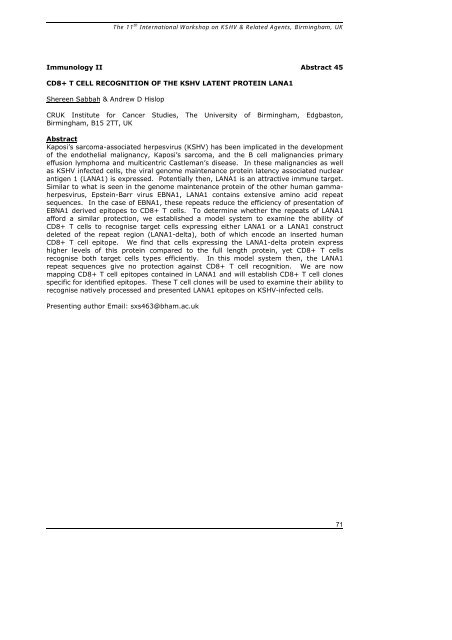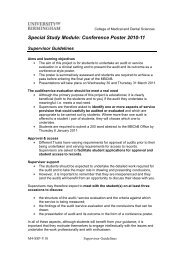Contents - College of Medical and Dental Sciences - University of ...
Contents - College of Medical and Dental Sciences - University of ...
Contents - College of Medical and Dental Sciences - University of ...
Create successful ePaper yourself
Turn your PDF publications into a flip-book with our unique Google optimized e-Paper software.
The 11 th International Workshop on KSHV & Related Agents, Birmingham, UK<br />
Immunology II Abstract 45<br />
CD8+ T CELL RECOGNITION OF THE KSHV LATENT PROTEIN LANA1<br />
Shereen Sabbah & Andrew D Hislop<br />
CRUK Institute for Cancer Studies, The <strong>University</strong> <strong>of</strong> Birmingham, Edgbaston,<br />
Birmingham, B15 2TT, UK<br />
Abstract<br />
Kaposi’s sarcoma-associated herpesvirus (KSHV) has been implicated in the development<br />
<strong>of</strong> the endothelial malignancy, Kaposi’s sarcoma, <strong>and</strong> the B cell malignancies primary<br />
effusion lymphoma <strong>and</strong> multicentric Castleman’s disease. In these malignancies as well<br />
as KSHV infected cells, the viral genome maintenance protein latency associated nuclear<br />
antigen 1 (LANA1) is expressed. Potentially then, LANA1 is an attractive immune target.<br />
Similar to what is seen in the genome maintenance protein <strong>of</strong> the other human gammaherpesvirus,<br />
Epstein-Barr virus EBNA1, LANA1 contains extensive amino acid repeat<br />
sequences. In the case <strong>of</strong> EBNA1, these repeats reduce the efficiency <strong>of</strong> presentation <strong>of</strong><br />
EBNA1 derived epitopes to CD8+ T cells. To determine whether the repeats <strong>of</strong> LANA1<br />
afford a similar protection, we established a model system to examine the ability <strong>of</strong><br />
CD8+ T cells to recognise target cells expressing either LANA1 or a LANA1 construct<br />
deleted <strong>of</strong> the repeat region (LANA1-delta), both <strong>of</strong> which encode an inserted human<br />
CD8+ T cell epitope. We find that cells expressing the LANA1-delta protein express<br />
higher levels <strong>of</strong> this protein compared to the full length protein, yet CD8+ T cells<br />
recognise both target cells types efficiently. In this model system then, the LANA1<br />
repeat sequences give no protection against CD8+ T cell recognition. We are now<br />
mapping CD8+ T cell epitopes contained in LANA1 <strong>and</strong> will establish CD8+ T cell clones<br />
specific for identified epitopes. These T cell clones will be used to examine their ability to<br />
recognise natively processed <strong>and</strong> presented LANA1 epitopes on KSHV-infected cells.<br />
Presenting author Email: sxs463@bham.ac.uk<br />
71















